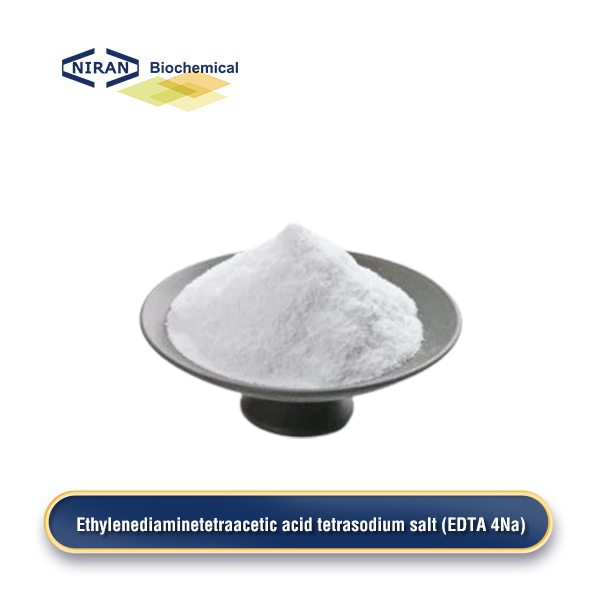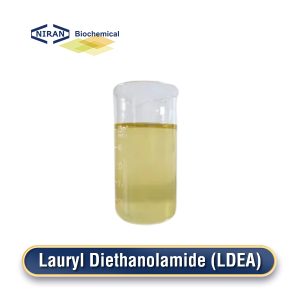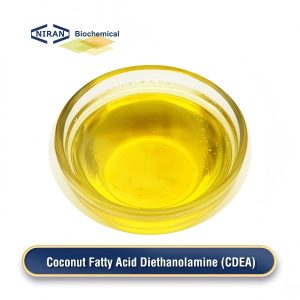Ethylenediaminetetraacetic Acid Tetrasodium Salt
- CAS Number: 64-02-8 (anhydrous), 13235-36-4 (tetrahydrate)
- Chemical Formula: C10H12N2Na4O8
- MOQ: 1000KG
- Shelf Life: 2 years
- Synonyms: EDTA tetrasodium salt/
- Tetrasodium salt of ethylenediaminetetraacetic acid/
- Sodium EDTA/EDTA-4Na
Product Description
What Is EDTA-4Na?
As a common chelating agent, ethylenediaminetetraacetic acid tetrasodium salt (EDTA-4Na) binds to metal ions to stop their negative effects in a variety of applications. It forms stable complexes by binding with metal ions like calcium. This makes it beneficial for the food, cleaning, water treatment, and pharmaceutical industries.
Preparation Method
EDTA-4Na is typically synthesized through the neutralization of ethylenediaminetetraacetic acid (EDTA) with sodium hydroxide (NaOH). The process involves dissolving EDTA in water and gradually adding sodium hydroxide to form the tetrasodium salt. The reaction is carried out under controlled conditions to ensure complete neutralization and to avoid the formation of by-products. The solid tetrasodium salt is obtained by drying and condensing the resultant solution.
Related Parameters:
| Item | Standard |
| Purity (by Titration) | ≥ 99% |
| pH (1% aqueous solution) | 10.0 – 11.0 |
| Water Content | ≤ 1.0% |
| Sodium (Na) | 10.5% – 11.5% |
| Chloride (Cl) | ≤ 0.05% |
| Iron (Fe) | ≤ 0.001% |
| Heavy Metals (as Pb) | ≤ 0.001% |
| Arsenic (As) | ≤ 0.0002% |
| Sulfate (SO₄) | ≤ 0.05% |
| Melting Point | 300°C (decomposes) |
Recommended Dosage:
| Applications | Dosage |
| Water Treatment | 0.05% – 0.5% |
| Industrial Cleaning Agents | 0.1% – 1% |
| Cosmetics & Personal Care | 0.05% – 0.3% |
| Pharmaceuticals | 0.01% – 0.1% |
| Food & Beverage (Preservative) | 0.01% – 0.05% |
| Toothpastes | 0.1% – 0.3% |
| Laundry Detergents | 0.1% – 0.5% |
| Metalworking Fluids | 0.1% – 0.5% |
| Agriculture (Fertilizers & Soil Treatment) | 0.05% – 0.1% |
| Antioxidant Formulations | 0.1% – 0.3% |
EDTA-4Na Has Wide Range of Uses:
- Water Treatment: EDTA-4Na is used to bind metal ions like calcium and magnesium in hard water, preventing scaling in pipes, boilers, and cooling towers.
- Industrial Cleaning: It is added to cleaning products to remove mineral deposits, soap scum, and limescale, improving the effectiveness of detergents in laundry, dishwashing, and surface cleaners.
- Pharmaceuticals: EDTA-4Na stabilizes IV solutions, blood products, and vaccines by preventing metal contamination and is used in detoxification therapies to remove heavy metals from the body.
- Cosmetics & Personal Care: It prevents oxidation and discoloration in products like shampoos, conditioners, and facial cleansers, extending shelf life and improving performance.
- Food & Beverage: EDTA-4Na acts as a preservative, preventing spoilage and discoloration in processed foods and beverages.
- Agriculture: Used in fertilizers and soil treatments, it helps improve nutrient availability to plants by chelating essential metals like iron and zinc.
User Asked Question:
Q: Is EDTA-4Na environmentally friendly?
A: EDTA-4Na is biodegradable under certain conditions, but it should be handled carefully to prevent contamination of water sources. For large-scale industrial use, it’s important to follow environmental safety guidelines.
Q: What makes EDTA 2Na different from EDTA 4Na?
A: Skin care products, shampoos, lotions, gels, dyes, cosmetics, and other cleaning supplies can all include disodium EDTA. When comparing EDTA-2Na with EDTA-4Na, the pH of EDTA-2Na is less than 7, whereas that of EDTA-4Na is greater than 7.



